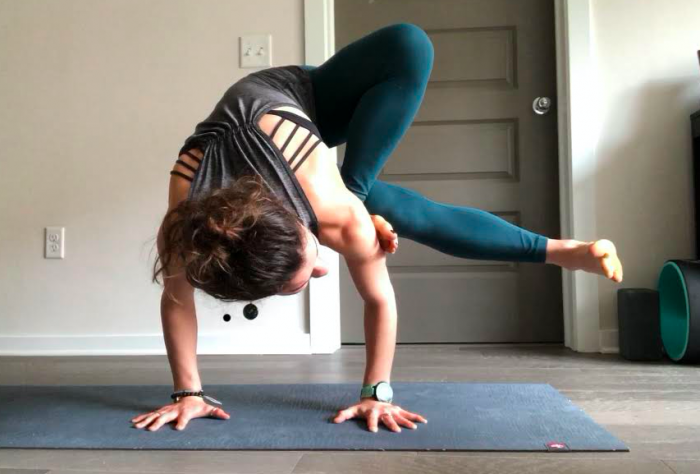Why do we fall off the exercise bandwagon?
We’ve all seen it. January hits and bam, everyone is at the gym, in yoga studios and pilates classes, and running outdoors. Now don’t get me wrong, I’m all for people wanting to engage in healthy forms of movement, but why do they stop? Why does February roll around and everything stops?
I’ll tell you why. It’s actually the simplest reason.
It is the same reason why after a 30 or 40-day challenge, people stop showing up. The reason why February and March have significantly fewer people in workout classes than January.
Here’s why.
It’s the all-or-nothing mentality. The “go big or go home” thoughts, and by home, I mean home to your couch to watch Netflix for days.
Why are we like this? Why does this happen? Why do we think that physical activity has to be defined by a certain type of activity, an exact duration of time or miles, or even a certain number of days each week or month for it to “count”? Also, why is this measurement and calculating celebrated by our society?
It is no surprise that we eventually fall off the bandwagon. We’ve been thinking about moving and movement all wrong.
How different would it be if each day we took a second to check in with our body before we chose what type of movement and exercise we would do? Your body knows what it needs way more than a weekly or monthly challenge does.
I can promise that you will be way more likely to move your body consistently and enjoy doing it if you are choosing a movement that works for you. When there’s not rigidity around it, we’re in choice. We’re free. We can move intuitively. We can choose what sounds good rather than defaulting to what we think we should be doing.
Another concept we don’t hear often is that sometimes intuitive movement means choosing stillness. You read that correctly. It’s normal to need stillness rather than vigorous exercise.
This is something that my clients, and on certain days even I, can find challenging. Why? Because we’re fighting the societal pressure to always be moving or doing. A day or week off does not mean failure nor does it mean you need to start all over again.
Here’s the thing, working on cultivating a healthier, more sustainable relationship with exercise means being okay with the grey, the place in between the extremes, the place where there’s a little bit more confusion yet total body trust.
Movement does not need to be all or nothing. It’s not black and white. If we only see movement and exercise through this lens, then we miss out on the opportunity to tune into our bodies, not our minds. One of the best benefits, in my opinion, of intuitive and joyful movement, is that we get to disconnect from the mind and instead connect to the body.
However, if we only see movement through the lens of all or nothing, then we lose the freedom found in movement. How many times have you forced yourself to do a workout, run, or go to a yoga or cycle class simply because “you should,” even though your body or life is asking you to do the opposite?
Now, compare that to a day when you joyfully chose to engage in movement that felt good.
Maybe a walk on a gorgeous day.
A few simple stretches at home.
A run along the beach.
Playing with your kids or dog.
An intuitive, slower paced yoga class.
Who knows? It’s different for each of us each day.
Movement can be joyful, fun, and feel good in our bodies. It can also be militant, rigid, and rough. The thing we most often forget is that we always have a choice. So choose what works for you. Go to the gym for 20 or 30 minutes instead of an hour. Practice yoga for part of the class and take Child’s pose for the remainder. Go for a nice walk with a friend instead of a forced run. Chase your kids around. Take a day off. Clean the messy room or dirty apartment instead of going to the gym.
Do what you need. It’s not all or nothing. You’re allowed to take breaks. You’re also allowed to try as many different types of movement as you wish. Find your favorites.
This is where my clients have their biggest breakthroughs. Movement becomes a celebration of what their body can do, not a rigid, militant approach to “better health.”
Here are some tips on how to get started:
1. Make a list
Make a list of all the different types of movement you enjoy and keep it somewhere you can refer to it.
Allow this list to include any and all types of movement—stretching, cleaning, bike rides, Zumba, walks, runs, weightlifting, swimming, rollerblading, or yoga.
2. Before choosing movement, check in with your body.
How does it feel? What type of movement sounds good? If you’re not sure, envision yourself doing it. What’s the immediate response/sensation you feel in your body? This will tell you a lot.
3. Be flexible
Be flexible with planning, timing, duration, and intensity.
You can have a plan, but be okay with adjusting it and changing it as needed.
Remember, we are more likely to continue to move if we make our movement enjoyable.
4. Be in the learning.
You won’t always get it right. Use each experience as a way to learn. How did your body feel during it? After it? What would you change for next time, if anything?
The more you tune in and try different things, the more intuitive movement will become. Keep learning.
If exercise is causing you more stress, leaving you feeling disengaged from your family or social life, or simply does not feel good in your body, take a different approach.
You’re in choice. Choose what serves you. Choose what supports your body and your life. Create your own definition of movement.









Read 3 comments and reply